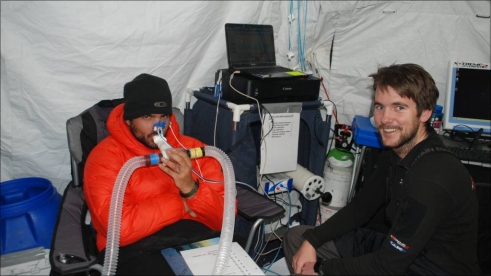The Hypoxic Ventilatory Response (HVR) study investigates how individuals alter their breathing in response to reduced levels of oxygen (hypoxia). The Xtreme Everest 2 team have been performing this HVR test at the London, Kathmandu and Base Camp laboratories.
The experiment involves breathing into a type of plastic bag, we then decrease your oxygen levels progressively and this stimulates you to breathe harder. The kit has been likened to ‘Meccano’ as it consists of a mass of tubes and coloured tape and looks slightly homemade, although it is actually quite robust. The HVR study decreases the subject’s blood oxygen saturations by 20%; the equivalent of climbing a further few thousand metres higher. Towards the end of proceedings the subject can get very breathless, making it one of the less popular tests with the investigators and subjects!
Variability between individuals may help explain different acclimatisation responses to high altitude exposure and also different tolerances to low oxygen (hypoxia) in the clinical setting. The Sherpa results have been particularly interesting. We have also been testing the 2007 Caudwell Xtreme Everest Summit Team to compare their results to the arterial blood samples collected during their successful Everest summit.
Tom Smedley, Everest base camp Investigator, XE2




